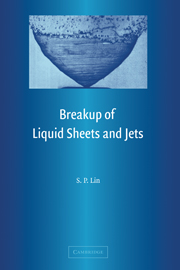Book contents
- Frontmatter
- Contents
- Notation List
- Preface
- 1 Introduction
- 2 Uniform Inviscid Liquid Sheets
- 3 Nonuniform Inviscid Liquid Sheets
- 4 Viscous Liquid Sheet
- 5 Waves on Liquid Sheets
- 6 Phenomena of Jet Breakup
- 7 Inviscid Jets
- 8 A Viscous Jet
- 9 Roles Played by Interfacial Shear
- 10 Annular Liquid Jets
- 11 Nonlinear Capillary Instability of Liquid Jets and Sheets
- 12 Epilogue
- Appendixes
- Author Index
- Subject Index
9 - Roles Played by Interfacial Shear
Published online by Cambridge University Press: 02 December 2009
- Frontmatter
- Contents
- Notation List
- Preface
- 1 Introduction
- 2 Uniform Inviscid Liquid Sheets
- 3 Nonuniform Inviscid Liquid Sheets
- 4 Viscous Liquid Sheet
- 5 Waves on Liquid Sheets
- 6 Phenomena of Jet Breakup
- 7 Inviscid Jets
- 8 A Viscous Jet
- 9 Roles Played by Interfacial Shear
- 10 Annular Liquid Jets
- 11 Nonlinear Capillary Instability of Liquid Jets and Sheets
- 12 Epilogue
- Appendixes
- Author Index
- Subject Index
Summary
This chapter elucidates the role of interfacial shear on the onset of instability of a cylindrical viscous liquid jet in a viscous gas surrounded by a coaxial circular pipe by using an energy budget associated with the disturbance. It is shown that the shear force at the liquid-gas interface retards the Rayleigh mode instability, which leads to the breakup of the liquid jet into drops of diameter comparable to the jet diameter because of capillary force. On the other hand the interfacial shear and pressure work in concert to cause the Taylor mode instability, which leads the jet to breakup into droplets of diameter much smaller than the jet diameter. While the interfacial pressure plays a slightly more important role than the interfacial shear in amplifying the longer wave spectrum in the Taylor mode, shear stress plays the main role of generating shorter wavelength disturbances.
Basic Flow
Consider the instability of an incompressible Newtonian liquid jet of radius R1. The jet is surrounded by a viscous gas enclosed in a vertical pipe of radius R2, which is concentric with the jet. For the jet to maintain a constant radius, the dynamic pressure gradients in the steady liquid and gas flows must maintain the same constant. This will allow the pressure force difference across the liquid-gas interface to be exactly balanced by the surface tension force as required. Such coaxial flows, which satisfy exactly the Navier–Stokes equations, are given by (Lin and Ibrahim, 1990).
- Type
- Chapter
- Information
- Breakup of Liquid Sheets and Jets , pp. 146 - 171Publisher: Cambridge University PressPrint publication year: 2003



